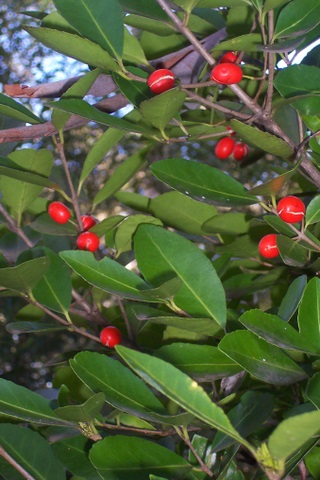Cassine Australis on:
[Wikipedia]
[Google]
[Amazon]

 ''Elaeodendron australe'', commonly known as red olive-berry, red-fruited olive plum, or blush boxwood, is a species of flowering plant in the family
''Elaeodendron australe'', commonly known as red olive-berry, red-fruited olive plum, or blush boxwood, is a species of flowering plant in the family
 ''Elaeodendron australe'', commonly known as red olive-berry, red-fruited olive plum, or blush boxwood, is a species of flowering plant in the family
''Elaeodendron australe'', commonly known as red olive-berry, red-fruited olive plum, or blush boxwood, is a species of flowering plant in the family Celastraceae
The Celastraceae (staff-vine or bittersweet) are a family of 98 genera and 1,350 species of herbs, vines, shrubs and small trees, belonging to the order Celastrales. The great majority of the genera are tropical, with only ''Celastrus'' (the staf ...
and is endemic
Endemism is the state of a species being found only in a single defined geographic location, such as an island, state, nation, country or other defined zone; organisms that are indigenous to a place are not endemic to it if they are also foun ...
to eastern Australia. It is a shrub or small tree with egg-shaped to oblong leaves with a wavy margin, yellowish green male and female flowers on separate plants and fleshy orange-red fruit.
Description
''Elaeodendron australe'' is a shrub or small tree that typically grows to a height of and has separate male and female plants. The leaves are mostly arranged in opposite pairs and are egg-shaped to elliptic or oblong with a wavy edge, long and wide on a petiole long. ''Elaeodendron australe'' is dioecious; that is, male and female flowers are borne on separate plants. The flowers are arranged incymes
In botany, an inflorescence is a group or cluster of flowers arranged on a plant's stem that is composed of a main branch or a system of branches. An inflorescence is categorized on the basis of the arrangement of flowers on a main axis ( ped ...
in leaf axils, on a peduncle up to long, each flower on a pedicel long. The four petals are yellowish-green, about long. Male flowers have four stamen
The stamen (: stamina or stamens) is a part consisting of the male reproductive organs of a flower. Collectively, the stamens form the androecium., p. 10
Morphology and terminology
A stamen typically consists of a stalk called the filament ...
s and female flowers have four staminode
In botany, a staminode is an often rudimentary, sterile or abortive stamen, which means that it does not produce pollen.Jackson, Benjamin, Daydon; ''A Glossary of Botanic Terms with their Derivation and Accent''; Published by Gerald Duckworth & Co ...
s. Flowering occurs in spring and summer and the fruit is a fleshy, oblong to oval, orange-red drupe
In botany, a drupe (or stone fruit) is a type of fruit in which an outer fleshy part (exocarp, or skin, and mesocarp, or flesh) surrounds a single shell (the ''pip'' (UK), ''pit'' (US), ''stone'', or ''pyrena'') of hardened endocarp with a seed ...
long. The fruit is ripe from March to July and often persists on the tree for many months.
Taxonomy
''Elaeodendron australe'' was first formally described in 1805 by √Čtienne Pierre Ventenat in his book '' Jardin de la Malmaison''. In 1825, de Candolle described two varieties in '' Prodromus Systematis Naturalis Regni Vegetabilis'' and the names are accepted by theAustralian Plant Census
The Australian Plant Census (APC) provides an online interface to currently accepted, published, scientific names of the vascular flora of Australia, as one of the output interfaces of the national government Integrated Biodiversity Information Sys ...
:
* ''Elaeodendron australe'' Vent. var. ''australe'' that has leaves less than four times as long as broad, and mostly more than wide;
* ''Elaeodendron australe'' var. ''integrifolium'' ( Tratt.) DC. (previously known as ''Portenschlagia integrifolia'') that has leaves more than four times as long as broad, and less than wide.
Distribution and habitat
Red olive-berry grows ineucalypt
Eucalypt is any woody plant with Capsule (fruit), capsule fruiting bodies belonging to one of seven closely related genera (of the tribe Eucalypteae) found across Australia:
''Eucalyptus'', ''Corymbia'', ''Angophora'', ''Stockwellia'', ''Allosyn ...
and rainforest ecotone
An ecotone is a transitional area between two plant communities, where these meet and integrate. Examples include areas between grassland and forest, estuaries and lagoon, freshwater and sea water etc. An ecotone may be narrow or wide, and it ma ...
areas, and in littoral
The littoral zone, also called litoral or nearshore, is the part of a sea, lake, or river that is close to the shore. In coastal ecology, the littoral zone includes the intertidal zone extending from the high water mark (which is rarely i ...
or dry rainforest. It is found in north-eastern and central eastern Queensland and as far south as Tuross Head in New South Wales. An unusual thick-leaved form occurs in Mount Kaputar National Park and nearby western slopes and dry tableland gorges.
Use in horticulture
Seed germination is very slow, but reliable with around a 25% success rate after twelve months.References
{{Taxonbar, from=Q5353115 australe Sapindales of Australia Flora of Queensland Flora of New South Wales Plants described in 1805 Taxa named by √Čtienne Pierre Ventenat Dioecious plants